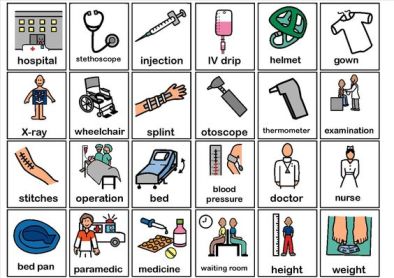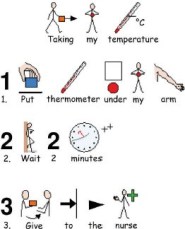Dr Kate Taylor | Dr Charlotte Clements
This article has come about through a Quality Improvement project at St Mary’s Hospital, London with the involvement of Stephanie Nash, a parent with first hand experience of the difficulties of autism in the ED who wants to work to improve this.
Attending the Emergency Department can be difficult for any child and their family. For children with a diagnosis of autism a trip to ED can be incredibly stressful. It is noisy, unfamiliar, and generally unpredictable, meaning the situation can be overwhelming for these children and young people (CYP).
Around 1 in 100 people has a diagnosis of an autism spectrum condition – meaning you will certainly come across a patient with this diagnosis at some point. Like in all developmental conditions autism is a spectrum, so each child or young person’s needs will be different. It is a good idea to develop a framework so you can approach and manage these patients confidently and with empathy.
Here is some general information about what autism can mean for children, plus some suggestions of how to make attending ED a less traumatic experience. Remember, these families will often only attend ED when they absolutely have to.
Your department may have some autism friendly schemes in place; if not, why not be an advocate for autistic children and try and introduce some of these suggestions?
What is Autism?
Autism is a developmental condition that affects the child or young person’s perception of the world around them and how they relate to people. Typical characteristics include:
1) impairment of language, communication and social interaction,
2) rigidity of behaviour and lack of imaginative play, and
3) disordered sensory perception.
The ED environment can be overwhelming for CYP with autism, which can affect their behaviour and lead to a complete meltdown where the child or young person loses all control. Remember that they are not being naughty or difficult. Placing them in a safe, quiet space with no loud noises or bright lights can help to calm them down.
Try and find a side room for the child to wait in right from the beginning, away from the noise of the waiting room. Children or young people with autism can be particularly sensitive to sound, touch, smell, light, colour, temperature or pain; background noises or images that we could ignore might be unbearable for them. They can interpret and process external visual, auditory and other sensory stimuli in different and unpredictable ways. For example, some CYP could be hypo-sensitive to pain, meaning that they have a very high threshold and may not show the typical pain responses you would typically expect, making it possible to miss something like a fracture. They may also show unusual responses such as laughter or humming, which we would not normally identify as a pain response. Alternatively children may be overly sensitive to touch, finding even light touches, plasters or cotton wool uncomfortable – making a physical examination very difficult. Similarly CYP with autism can be hyper-sensitive to sound, and the loud noises of the waiting room can become distorted and distracting. Even the lighting in ED can be disturbing or even painful. Previous negative experiences will also influence how the child or young person responds. All of this makes assessment and treatment tricky. Doctors and nurses may find that they can over- or under-investigate and treat patients because of their autism. Should you avoid doing blood tests because it will be too upsetting? Should you do the blood tests because the patient can’t verbalise what is wrong and you might be missing something?
It goes without saying that if the parents feel that something is wrong, even (or especially) when the clinical picture doesn’t fit – trust the parent’s instinct and act accordingly.
Understand your patient’s needs
It is clearly best to know in advance whether any child has a physical or developmental need. The triage nurse is often the first medical professional families will meet in the department so will be the best person to ask this (and communicate it to the team). However some parents don’t want to say the word ‘autism’ in front of their children or discuss their disability as it upsets them. Give the parents the opportunity to speak up – you could try putting posters up at triage inviting parents to let you know about any communication needs, or have an electronic alert which flags up that the patient has a diagnosis of autism. A one-page autism alert card or patient passport can be a useful tool for parents to provide you with this information, can be filled out quickly in the waiting room (and saves them having to repeat the same story to all professionals they meet!) Some hospitals have their own generic passport and the National Autism Society website has a free downloadable example to use. Advanced warning on what patients like, don’t like, potential sensory triggers and how they communicate is invaluable.
Equipment
Speak to your play specialist – they may have some equipment already or have a wish list of what they would like (your hospital charity may be happy to help with funding). Ear defenders can help keep children calm plus a selection of sensory toys (eg squeezy balls) to keep them entertained. It may be helpful to keep some PECS cards or for you to learn some basic Makaton signs (YouTube has loads of resources) to help you communicate with the child directly – even if they can’t speak they can still have the opportunity communicate with you.
 Example hospital-themed PECS cards
Example hospital-themed PECS cards
Sand timers or clocks may help children to visualise and understand how long they will be waiting around for. A toy or model can be used to show the child what will happen during a physical examination, which could help to reassure them. Social storiesTM,1 explain day-to-day situations in simple terms and is a useful resource for explaining to children what happens at the doctor (find out more about Social Stories here, and how to create a tailored one for your department). Finally, all children enjoy rewards – have something that they can look forward to and can be seen as marking the end of their ED journey.
Communication
All children with autism have different preferred ways to communicate. Ask the parents how best to approach their child – how do they communicate? Are they verbal, or do they use signs and pictures? Are they ok with being touched or will this cause upset? Use charts or pictures so they can point and show where they have pain or discomfort, or what symptoms they have, and visual aids like scales or facial expressions to indicate severity of pain or stress.
Children with autism can often interpret what you say very literally and won’t understand vague expressions. For example, if you say you’re going to have “one” attempt at bloods, then that is all you will get! Saying something will be “a few minutes” may be difficult for them to understand.
Preparing the child
 A common stressor for children with autism is any change from their normal routine. Try as much as possible to let the child know what is going to happen. A visual roadmap or checklist showing the journey through the emergency department may help – i.e. start at reception, then go to triage, then have observations, then wait to see the doctor, then the doctors will talk to you, then examine you etc.
A common stressor for children with autism is any change from their normal routine. Try as much as possible to let the child know what is going to happen. A visual roadmap or checklist showing the journey through the emergency department may help – i.e. start at reception, then go to triage, then have observations, then wait to see the doctor, then the doctors will talk to you, then examine you etc.
Some parents may find it helpful to attend the ED in advance and be shown round, so the child is familiar with the environment before they have to attend as an emergency. Encourage parents to use doctors toy sets as part of play at home to familiarise them with the equipment they may encounter.
Pictorial storyboards describing simple procedures can help the child understand what needs to happen, for example the steps in taking their temperature might be²:
All of these tips can be adapted for the clinic setting with a few additional considerations – for example when seeing children in clinic it may be necessary to give them the first or last appointment to avoid waiting too long, and booking a double appointment slot to allow for extra time may be a good idea.
Staff Education
Formal education and training in managing CYP with autism in not something that everyone will have received. Organising some departmental teaching on the subject of autism and learning difficulties will improve staff confidence in approaching CYP with autism, and improve their understanding of ways to make the ED experience less stressful. There may be a nurse in your department with an interest in learning difficulties who would be able to deliver training locally.
Summary
All children with autism are different and individual. It can be challenging to assess and treat them in the unpredictable environment of the Emergency department. Children typically have difficulties with 3 areas:
- Communication and social interaction
- Behaviour
- Sensory perceptions
Take home messages
Find out how the child communicates and how best you can communicate with them by using patient passports and involving the parent
Keep the child calm – this could mean keeping them in a cubicle away from the noisy waiting room and using sensory toys or ear defenders.
Remember that they may not show ‘typical’ pain responses – be careful in your assessment and listen to their parents.
Explain in simple terms and a logical sequence of what will happen – and stick to what you say
Dr Kate Taylor, Paediatric registrar, with consultant input from Dr Charlotte Clements, Paediatric Emergency Medicine consultant

I know there will be objectors whatever choice of language is made but may be worth noting that “autistic people” is preferred in eg NICE style guide, NAS website. Think the reasoning is persuasive here:
https://www.autism.org.uk/what-we-do/help-and-support/how-to-talk-about-autism
Likewise “disabled people” seems to be the preferred in advocacy circles at least.